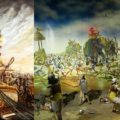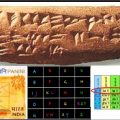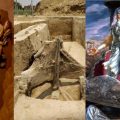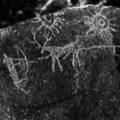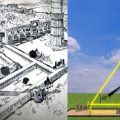Mahabharata War 7500 Years Ago? What Astronomical Calculations Say!
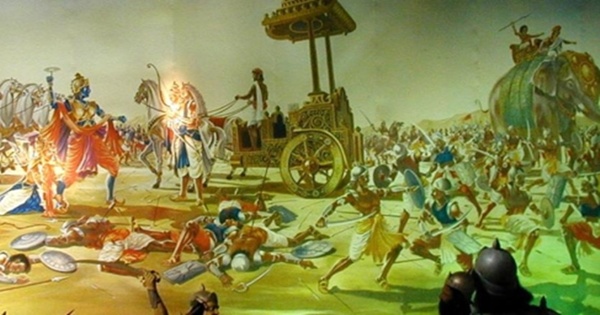
Indic civilization dates back to antiquity, spanning thousands of years. European historians dropped one zero from the figure of 15,000 years and stamped 1500 BC as start of Vedic civilization! It is an irony that Wikipedia enlists Vedic period as the period between 1500 to 600 BCE, going by this theory. This calculation is null and void. The Ramayana and the Mahabharata have been deemed as imaginary and fictitious by few historians. But archaeological evidences, right from the Ram Setu to discovery of the submerged city of Dwarka under the sea waters and other proofs corroborate their historicity. Rama and Krishna existed. The Mahabharata war did take place. Vedic period is beyond the Mahabharata and the Ramayana.
What about the dating of the Mahabharata war? When did this war take place? The dating of the Mahabharata war has been a matter of challenge and controversy for some time. While different researches conducted by scholars of the Mahabharata point out different dates, research by Nilesh Nilkanth Oak concludes the date of the Mahabharata war at 5561 BCE. More than 7500 years ago! He has documented his research work in his book When Did The Mahabharata War Happen? The Mystery of Arundhati. The author has been nominated for the Lakatos award by London School of Economics for a contribution to the philosophy of science for this book.
Nilesh Nilkanth Oak banked upon 200+ astronomy and associated observations from the Mahabharata text. It took him 15 plus years to come to a conclusion. Each piece of evidence fell in place, leading him to 5561 BCE. The discovery of his claim falsified more than 120 alternate claims to the dating of the Mahabharata war.
Sri Oak researches in astronomy, archeology, anthropology, quantum mechanics, economics, naturopathy, ancient narratives and philosophy. Here is an excerpt of an interview of Nilesh Nilkanth Oak taken by Manoshi Sinha, Editor of My India My Glory e-magazine on the dating of the Mahabharata war.
Manoshi Sinha: You evaluated astronomy observations of the Mahabharata text and wrote a book on this. Please tell us about your journey on your interests in Astronomy and ancient Indian History.
Nilesh Nilkanth Oak: Although my foray into astronomy and ancient Indian history was sudden and by accident, the journey had been grueling. The journey involved balancing between multiple worlds of work or family, while viewing the whole process of the Mahabharata, not only by visualizing the sky conditions and star pairs but also by re-living the whole civilization – human conditions, technology, teachings and lessons learnt from it.
I was researching the Mahabharata text to test a claim (now discredited by my own works and by works of many others) that the Bhagavad Gita was inserted into the Mahabharata. I came across numerous astronomy references – relative movement of stars, positions of planets, the Sun and the Moon, positions and phases of the Moon, descriptions of comets and eclipses, descriptions of seasons and corresponding lunar months. This was fascinating and new to me. However, one specific observation, now famous – Arundhati Vasishtha (AV) observation captured my attention. The description of this observation was considered impossible by all Mahabharata researchers and most of them had, prematurely, carelessly and casually, discarded it as a plausible interpolation.
I thought otherwise. I named this problem, ‘The mystery of Arundhati’. Over the next 15 years, I was passionate after this observation and wanted to solve the mystery of it. I studied astronomy, developed numerous thought experiments, tested all of them, and finally, in 2009, I successfully solved the mystery of AV observation. The scientific force of this discovery was huge as it instantaneously, and decisively, falsified virtually all existing claims for the year of Mahabharata war.
Of course, I am not the first to achieve such a thing. Science is full of such revolutionary stories where one critical experiment falsified established theories and paved the way for the growth of knowledge.
MS: There has been rave reviews about your book When did the Mahabharata War Happen? The Mystery of Arundhati. So, when did the Mahabharata war actually happen as per your research and calculations?
Nilesh Nilkanth Oak: Thank you. What Arundhati Vasishtha observation established is that the Mahabharata war happened sometime before 4508 BCE. Of course, the big deal of this inference is to recognize that the Mahabharata war did not happen any time after 4508 BCE. This a big deal because virtually all alternate claims prior to 2011, when I published my book, and interestingly, virtually all alternate claims since 2011 claim that Mahabharata war occurred after 4508 BCE. Naturally, they cannot explain AV observation for their timeline. Until 2011, they could get away by ignoring AV observation, but now no one can.
But back to the story,
This is when I started studying Indian astronomy – nakshatras, tithis, seasons, lunar months and adhika masa, peculiarities of Luni-solar calendar, precession of the earth’s axis and its effects on season, lunar months, relative motions of star pairs.
I read and re-read the entire Mahabharata text multiple times, searching for astronomy and associated observations. I found more than 200. I tested each of them, either individually, or in groups, scientifically, to arrive at 5561 BCE as the year of the Mahabharata war. More than 7500 years ago.
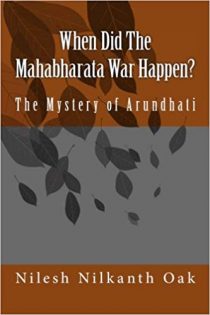
Click here to buy Kindle edition of When Did The Mahabharata War Happen? The Mystery of Arundhati. For paperback edition, click here.
MS: Please enlighten us about your methodology of research.
Nilesh Nilkanth Oak: My method is the well-honed Hypothetico-deductive method of science. The steps can be described as follows:
1. Begin with a tough problem, not solved by others or one that has no satisfactory solution
2. Propose a hypothesis (or multiple hypotheses – guesses, conjectures)
3. List the predictions/consequences due to a specific hypothesis. This includes the potential solution to the problem one is trying to solve. The consequences/predictions make the scientific method refutable.
4. If subsequent empirical investigation does not demonstrate these consequences/predictions as something objective, i.e. observable in the real world, the hypothesis is concluded as false.
5. If unsuccessful, try another hypothesis. Repeat steps 1 through 4.
Numerous elements of this scientific method, in depth, are discussed in Indian philosophy of ancient India, i.e. Nyaya (न्याय), Vaisheshika (वैशेषिक), Samkhya (सांख्य), Yoga (योग), Mimamsa (मीमांसा) and Vedanta (वेदांत) दर्शन.
To solve a problem, one proposes a solution – प्रमेय (a conjecture, theory, hypothesis). The proposed hypothesis leads to consequences/predictions (अनुमान) which are then compared against actual evidence – प्रमाण (experiments, observations, nature) and if predictions match the observations (error elimination), the hypothesis (प्रमेय) is accepted as an established theory (सिद्धांत), albeit temporary, until it is replaced by a better theory.
Sir Karl Popper describes this as a triad of explanation-prediction-testing in the context of a theory and in the context of the relevant background knowledge. We can visually illustrate it in the context of AV observation, as follows,
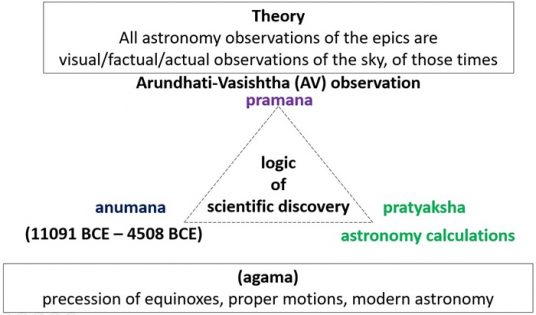
This scientific method is neither specific to a problem (e.g. chronology of Mahabharata) nor specific to a discipline of science (e.g. astronomy). It is universally applicable, and it must be applied. Refusal to follow it would lead to wrong answers and/or confusion and delusion.
MS: Challenges you faced in your research on the dating of the Mahabharata war.
Nilesh Nilkanth Oak: Many. The sheer volume of evidence, 200+ astronomy and associated observations, was overwhelming. Also, it is important to realize that a new successful theory leads to newer problems of greater complexity.
What benefitted me most was the fact that I was testing these 200+ observations for 15+ years, while I was still busy solving the problem of AV observation. Thus, although there were challenges in testing, I was rather astonished how each piece of evidence was falling in place and leading me to 5561 BCE.
MS: Is your research based only on Astronomy or other factors too? Please elaborate.
Nilesh Nilkanth Oak: Great question. Yes, I arrived at 5561 BCE as the year of Mahabharata war based on 200+ astronomy and associated evidence internal to the Mahabharata text.
One of the key requirement of a scientific theory is that it is consistent. What this means is once a theory is proposed, all the evidence that falls under the scope of a theory must be considered. It also means that any evidence that is not relevant under the scope of the theory must not be brought in.
The illustration would be helpful. My theory stated that ‘all astronomy observations of the Mahabharata text are actual/factual/visual observations of the sky of Mahabharata times’. This meant I must stick to only astronomy and associated evidence and I must include all such astronomy evidence. At the same time, I must refrain from bringing in or discussing any other evidence or aspects of evidence that is non-astronomy in nature.
Of course, once a theory and corresponding evidence leads to a specific conclusion (e.g. 5561 BCE as the year of Mahabharata war), then one must test this claim using other disciplines of science. I have indeed validated this claim of 5561 BCE via multidisciplinary evidence from hydrology/geology, oceanography, climatology, seismology, genealogy and genetics.
MS: There have been different opinions, all research based, on the date of the Mahabharata war. What is your opinion on these. Did these opinions affect your research?
Nilesh Nilkanth Oak: (laughs). How much time do you have?
There is no room for opinions, mine or those of other researchers, in a scientific research.
Of course, individual opinions, biases, intuitions and assumptions do play a role in conceiving of a new theory and that is all fine. In fact, irrationality and metaphysics play a huge role in formulations of new bold theories. This is not understood by many.
However, once a theory is proposed, the role of opinions, viewpoints, biases, intuitions, assumptions and metaphysics is over, at least until the fate of a current theory is decided. To do this, there is a method that one ought to follow. Science demands it. Unfortunately, majority of Mahabharata researchers are clueless about science and how a scientific research is to be done. The situation is extremely pathetic and worrisome.
Take for example, eleven elements of ‘Scientific acumen’ (विज्ञान बुद्धी): (1) Aim (2) separation (3) classification (4) distinction/gradation (5) sequencing (6) association (7) objective testing (8) error identification & elimination (9) causality (10) unification and (11) being skeptical of one’s own theory.
Barring few exceptions, that I can count on the fingers of my one hand – Shankar Balakrishna Dikshit, Pandurang Vaman Kane, Padmakar Vishnu Vartak, all existing or past Mahabharata researchers have not shown even awareness of 9 of the 11 elements of ‘scientific acumen’ and this ignorance is one of the key reason why they have made erroneous claims. Of course, Mahabharata researchers either pretend that these errors don’t exist or are unwilling to learn from their blunders!
Of course, I learnt a lot from their mistakes and my own, and I am thankful to them. Since there were 130+ claims when I entered this field, these claims provided me with the opportunities to test Mahabharata evidence for their claimed year(s) of Mahabharata war, to falsify their claims and to learn from their errors.
MS: What are the 2 elements of ‘scientific acumen’ where other researchers, per your claim, have done a decent job?
Nilesh Nilkanth Oak: (laughs). All of them did fine in stating or claiming that their aim was to determine the year of Mahabharata war and they showed rudimentary understanding of ‘objective testing’. Unfortunately, the luck ends here.
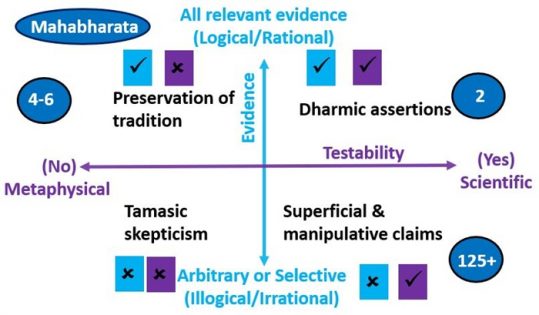
All of them showed gleeful ignorance towards the basic requirement of testing ‘all relevant evidence’. Only to demonstrate how deep is this rot, if we classify efforts of all Mahabharata researchers based on two simple categories of ‘evidence’ and ‘objective testing’, 99%+ claims for the year of Mahabharata war fall into the category of ‘superficial and manipulative claims’! These claims do show rudimentary comprehension of ‘objective testing’ yet fell to recognize that deliberate omission of majority of relevant evidence meant that their claim(s) were false, even by their own admission.
MS: Did you face criticism on your dating of the Mahabharata war? Please also enlighten us with the appreciations for your work on this.
Nilesh Nilkanth Oak: If you don’t face criticism you have not accomplished anything of importance. I crave for and insist on criticism that is both, brutal and rational. Criticism comes when the work has taken a mile’s stroll. Yes, I indeed received it. My theory and my claim benefitted immensely because of it.
Many Indic researchers, strategists and thinkers personally verified my claims and have showered praise. Numerous individuals from around the world, from academia, technology, business, astronomy groups, science forums, social organizations and ordinary walks of life continue to express their appreciation. I was invited to present at numerous conferences and public presentations. I have received numerous open invitations for talks from around the world.
MS: So, going by your dating of the Mahabharata war, what is your view on how old our Indic civilization is. Please also give references.
Nilesh Nilkanth Oak: Let’s begin with Mahabharata in the 6th millennium BCE. As you may be aware, I have established timing of Ramayana in the late 13th millennium BCE (12209 BCE). Thus, the astronomy evidence of Mahabharata and Ramayana, alone, establishes 15,000+ years of Indic civilization.
When I triangulated these chronologies with textual descriptions of river Sarasvati from the epics and Rigveda, along with hydrology/geology evidence, I could establish the timing of Rigveda from 6th millennium BCE (latest mandala -10) to sometime before 20,000 BCE (earliest mandalas – 6,3, 7, 4, 2).
I am working with Ms. Rupa Bhaty, my co-researcher, on the antiquity of सूर्य सिद्धांत (Surya Siddhanta) and this work alone establishes 15000+ years of Indic civilization. The publication is in the works.
Frankly, there are many additional clues to deeper antiquity of Indic civilization, but this will do for now. (laughs).
Our current knowledge for the antiquity of Indic civilization can be illustrated visually as follows:
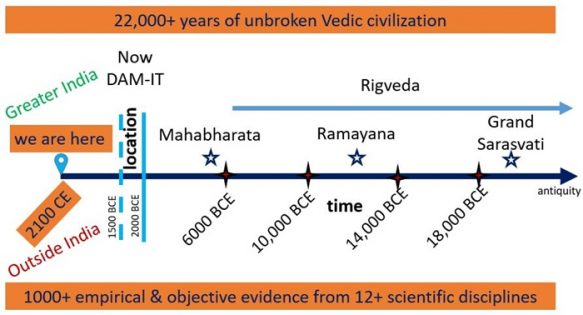
MS: How is your theory scientific and more genuine compared to other claims on dating of the Mahabharata war?
Nilesh Nilkanth Oak: This is a great question. Let me list key characteristic features of a revolutionary scientific theory.
1. It has a simple and clear universal statement
2. It is consistent and does not rely on unrelated a priori assumptions
3. It leads to objective and severe testing of evidence
4. It preserves past successes (unrefuted evidence)
5. It explains new evidence not explained by other theories
6. It leads to new predictions/inferences, not imagined by other theories
7. The validation of such novel predictions occurs
My theory distinguishes itself from all other claims on each of these counts.
1. The universal statement of my theory states, ‘All astronomy and associated observations of the Mahabharata text are actual, visual or factual observations of the Mahabharata times.
2. My theory relies on all astronomy evidence internal to the Mahabharata text and does not depend on any a priori external assumptions (Kali-yuga, iron age, horses, chariots, drying of rivers, agriculture, oceanography, climatology).
3. My theory leads to objective testing of evidence not only that is already identified (200+) but also that may be identified in future, internal to the Mahabharata text. In fact, since the publication of my book in 2011, I identified 100+ additional evidence internal to Mahabharata text and it all leads to 5561 BCE.
4. My theory has preserved past successes (e.g. 16 October -2 November, 5561 BCE – 18 day timeline of the war proposed by Dr. P V Vartak)
5. My theory not only explained AV observation for the first time but also established unique upper and lower limits for the chronology of Mahabharata war.
6. My theory led to numerous new predictions (too many to list), e.g. duration of Bhishma on the bed of arrows to be greater than 92 days, oblique and retrograde movements of planets, war taking place at the beginning of the Sharad season, etc.,)
7. Each of these novel predictions were validated for the year 5561 BCE.
Of course, there are numerous other criteria by which the scientific nature of my theory vs the non-scientific nature of other claims can be explained.
For example, while my theory clearly lists few (only 5 out of the 200+) observations that conflict with my claim of 5561 BCE timeline, no other researchers dare state which specific observations conflict with their claims. In fact, they either ignore such observations or explain them away. I must emphasize that these 5 observations conflict with rest of the internal evidence of Mahabharata. In addition, no other Mahabharata researcher has been able to explain these 5 observations successfully.
The circumstances under which my theory is falsifiable are in built into the theory itself, as it should be for any scientific theory. This is not the case for other claims. This is because while my approach is that of hypothetico-deductive method and thus that of deductive predictions followed by objective testing, other researchers began, in most cases, with a priori assumptions, followed by selective evidence (only that evidence which they ‘thought’ matched their claims) which in turn was explained via justification as opposed to objective testing. The real scenario for all alternate claim is lot worse than I am describing here briefly.
Again, I can go on, but this will do for now.
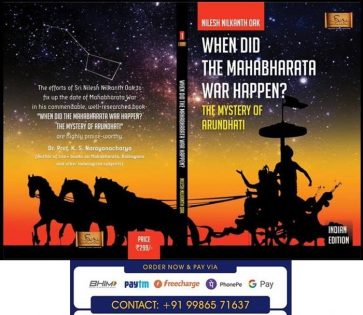
Indian Edition of ‘When Did the Mahabharata War Happen’ by Nilesh Nilkanth Oak. Book can be ordered via mobile no displayed below the book cover image.
MS: Your message to readers.
Nilesh Nilkanth Oak: Read and then read some more. ‘Being aware’ is the least every Indian should aspire for. Be proud of the fact that human civilization, and specifically Indic civilization has deep antiquity, that is established for 22,000+ years, via evidence from 12+ disciplines of science. Let no one tell you otherwise. Although many of our ancient records have been either lost or deliberately destroyed by foreign invasions, whatever little we are left with is still a lot and can tell us a lot about our ancient past. It is the duty of everyone of us to preserve, read and research this ancient treasure to understand our past and employ it creatively to bring prosperity for now and the future.
My message to other researchers is to come forward for a healthy debate to establish the truthful chronology which is critical for India’s grand narrative. Scientific method and logical reasoning, as espoused in Nyaya-Samkhya-Yoga-Vaisheshika darshanas of Indian philosophy coupled with desire to analyze all relevant evidence, from every single discipline of science provides the basis for a healthy debate. And while it may be left to few individuals to carry out the original research, it is the duty of every Indian to first comprehend and then actively distribute this knowledge, with whatever skills and means they have, to fellow Indians.
About Nilesh Nilkanth Oak
Mr. Nilesh Nilkanth Oak is the author of ‘When did the Mahabharata War Happen? The Mystery of Arundhati’ (2011), where he freshly evaluated astronomy observations of Mahabharata text. His work led to validation of 5561 BCE as the year of Mahabharata War while falsifying more than 120 alternate claims. The book was nominated for the Lakatos award; the award is given annually by London School of Economics for a contribution to the philosophy of science.
He published ‘The Historic Rama’ in 2014.

Nilesh Nilkanth Oak
He writes extensively on ancient Indian history at his blog. Nilesh studied in India, Canada and USA and holds BS and MS in Chemical Engineering and also executive MBA.
Featured image courtesy: saidstiffing.ga.
Latest posts by manoshi sinha (see all)
- What if Shaikh Paltu had Helped Mangal Panday instead of British? - October 23, 2024
- Shivaleela: Celebration of Shiva in this 21st Century Gurukul - October 23, 2024
- INA Veteran Lt Madhvan Appeals for Installation of Statue of Rash Behari Bose in Delhi - October 23, 2024

